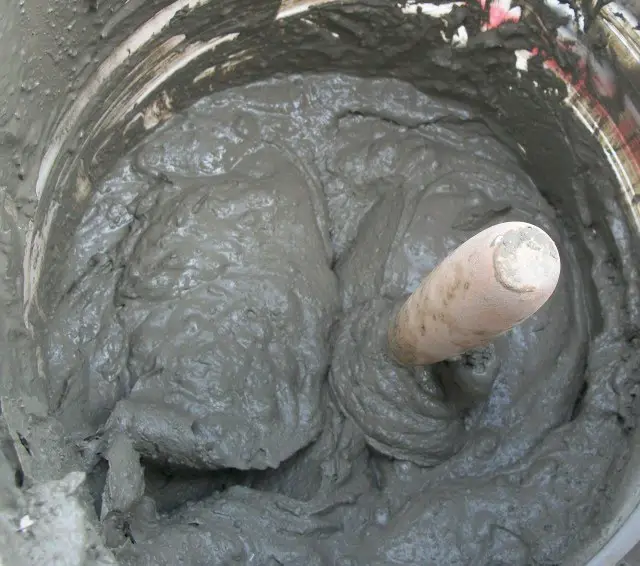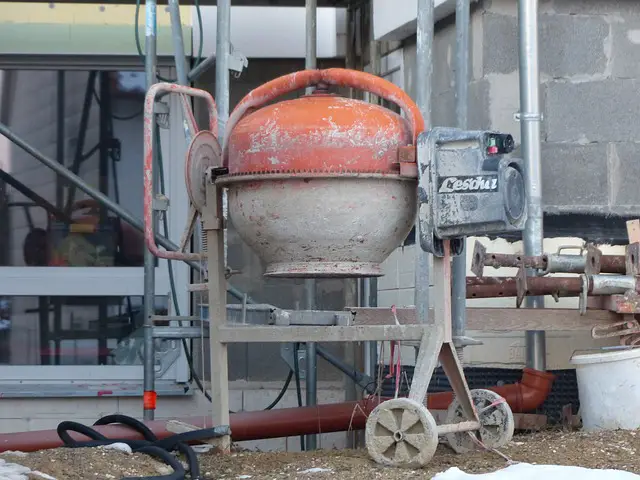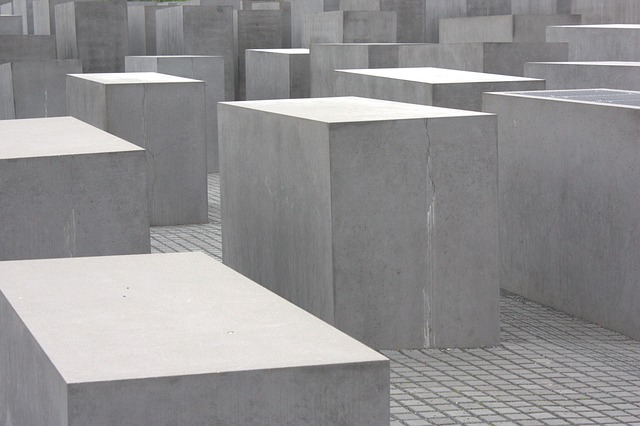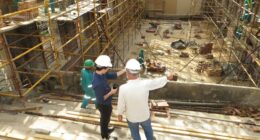Did you know that concrete and mortar, two commonly used building materials, have distinct differences that impact their strength, uses, and composition? Understanding these differences is crucial for construction projects to ensure the right material is utilized for the job.
Cement, a fine binding powder, serves as the foundation for both concrete and mortar. However, they have unique properties that make them suitable for different purposes. While concrete is a robust structural material, mortar acts as a bonding agent for masonry materials like brick and stone.
In this article, we will delve into the composition of concrete and mortar, explore their various uses, analyze their strength and durability, discuss consistency differences, and explore pre-mixed options and mixing methods. By the end, you will have a comprehensive understanding of the disparities between concrete and mortar, and how to choose the right material for your construction needs.
Key Takeaways:
- Concrete and mortar are distinct building materials with different compositions and properties.
- Concrete is strong and often used for structural purposes, while mortar is a bonding agent for masonry materials.
- Understanding the differences between concrete and mortar helps in selecting the appropriate material for construction projects.
- Proper composition, mixture ratios, and consistency impact the strength and durability of both concrete and mortar.
- Pre-mixed options and on-site mixing methods offer flexibility and convenience for construction projects.
Composition of Concrete and Mortar
Concrete and mortar are essential building materials that are composed of different ingredients, each with its specific purpose. Understanding the composition of concrete and mortar is crucial for using them effectively in construction projects.

Composition of Concrete
Concrete is a versatile material that is commonly used in various construction applications. It is composed of the following components:
| Component | Function |
|---|---|
| Cement | Binds the mixture together |
| Sand | Provides stability and strength |
| Aggregate (Gravel) | Adds bulk and improves durability |
The cement acts as a binding agent, holding the sand and aggregate together to create a solid and robust material. The specific proportions of cement, sand, and aggregate may vary depending on the desired strength and texture of the concrete.
Composition of Mortar

Mortar, on the other hand, is primarily used as a bonding material for masonry projects, such as bricklaying or stonework. It is composed of:
| Component | Function |
|---|---|
| Cement | Binds the mixture together |
| Fine Sands | Improves workability and durability |
| Lime | Enhances workability and flexibility |
The fine sands and lime in mortar help to enhance its workability and durability, making it easier to apply and improving the bond between masonry materials.
Overall, the composition of concrete and mortar differs in terms of the presence of aggregate and the specific mixture ratios of cement, sand, and other components. Understanding these differences allows for the proper selection and use of each material in construction projects.
Uses of Concrete

Concrete is a versatile building material that finds application in a wide range of construction projects. Its strength, durability, and adaptability make it a preferred choice for various structural applications.
Structural Slabs
One of the primary uses of concrete is in the construction of structural slabs. These slabs provide a solid foundation and support for buildings, bridges, and other large structures. Concrete’s ability to withstand heavy loads and resist cracking makes it an ideal material for creating stable and long-lasting slabs.
Poured Foundations
Another common use of concrete is in poured foundations. Concrete’s strength and ability to withstand moisture make it well-suited for creating a robust foundation for buildings. Poured concrete foundations provide stability, protect against water intrusion, and support the entire structure above.
Permanent Structures
Concrete is often used for the construction of permanent structures such as walls and sidewalks. Its durability and resistance to weathering make it a reliable choice for creating long-lasting and low-maintenance structures. Concrete walls provide strength and security, while concrete sidewalks offer a solid and safe surface for pedestrians.
Reinforcement
Concrete can be reinforced with metal mesh or rebar to enhance its strength and resistance to cracking. Reinforced concrete is commonly used in structures that require added durability and structural integrity, such as bridges, high-rise buildings, and retaining walls. The reinforcement adds strength by distributing the load and reducing the risk of failure under stress.
| Uses of Concrete | Description |
|---|---|
| Structural Slabs | Provides a solid foundation and support for buildings, bridges, and other large structures |
| Poured Foundations | Creates a robust foundation that protects against water intrusion and supports the entire structure |
| Permanent Structures | Used for constructing durable walls and safe sidewalks |
| Reinforcement | Metal mesh or rebar added to enhance strength and reduce cracking in high-stress structures |
Uses of Mortar
Mortar is a versatile and essential binding material used in a variety of construction projects involving brick, block, and stone. Acting as a “glue,” mortar plays a crucial role in holding these masonry materials together, creating durable structures.
Although mortar is not as strong as concrete, it is still an indispensable component in many building applications. Let’s explore some of the common uses of mortar:
- Joining Bricks and Blocks: Mortar is widely used for joining bricks and blocks to construct walls, both interior and exterior. The adhesive properties of mortar ensure a secure and long-lasting bond between these masonry units, providing stability and structural integrity to the walls.
- Creating Barbecues and Pillars: Mortar is used to create barbecues, pillars, and other vertical structures. It helps hold the individual bricks or stones together, allowing for the construction of robust and visually appealing features in outdoor spaces.
- Tuck-Pointing Mortar Joints: Over time, mortar joints between bricks or blocks can deteriorate. Tuck-pointing is a process that involves removing the old mortar and replacing it with fresh mortar. This technique helps restore the strength and stability of the structure, enhancing its overall durability.
- Building Planters and Garden Walls: Mortar is an excellent choice for building planters and garden walls. Its binding properties ensure that the individual stones or bricks remain firmly in place, creating attractive and functional outdoor elements.
When selecting mortar for a specific project, it is important to consider the type of mortar that best suits the application. Mortar is available in different types, each with its unique properties and uses. For brick and block work, Type S mortar is commonly used due to its strength and durability.
| Type of Mortar | Composition | Uses |
|---|---|---|
| Type S Mortar | 1 part Portland cement, 1 part hydrated lime, 3 to 4.5 parts sand | Bricklaying and block work |
| Type N Mortar | 1 part Portland cement, 1 part hydrated lime, 5 to 6 parts sand | Exterior and above-grade brickwork |
| Type M Mortar | 1 part Portland cement, 1/4 to 1/2 part hydrated lime, 3 to 4.5 parts sand | Constructions requiring high strength |
The specific mortar type should be selected based on factors such as the project’s requirements, environmental conditions, and the masonry materials being used.
Strength and Durability
Concrete and mortar are building materials with different strengths and uses. Concrete is super strong because it has big pieces of rock, called aggregate, mixed with cement and sand. The amounts of cement, sand, and aggregate used in concrete affect how strong it becomes. Mortar, on the other hand, is not as strong as concrete, but it’s still tough enough for its job in holding bricks, blocks, and stones together. Mortar is made of cement, fine sands, and sometimes lime.
One important thing affecting both concrete and mortar is the water-to-cement ratio. This ratio decides how much water is needed for the cement to properly set and become hard. Too much water can make both concrete and mortar weaker, but less water can make them more durable and tough.
Overall, concrete is known for being super strong, while mortar is good enough for sticking things together in buildings. The right mix of ingredients and the right amount of water make sure they do their jobs well.
Differences in Consistency
Concrete and mortar have distinct consistencies that contribute to their different applications in construction. Understanding the differences in consistency can help in selecting the appropriate material for various projects.
Consistency of Concrete:
Concrete has a thicker consistency compared to mortar. This is primarily due to the presence of larger aggregates in the concrete mixture. The addition of these larger aggregates, such as gravel, contributes to the solid and dense texture of concrete. The thicker consistency of concrete makes it suitable for structural applications, where strength and durability are crucial.
Consistency of Mortar:
In contrast, mortar has a thinner consistency compared to concrete. This is because mortar typically does not contain larger aggregates. The absence of larger aggregates allows mortar to have a smoother and more spreadable texture, making it easier to work with as a bonding agent for masonry materials. The thinner consistency of mortar facilitates the proper adhesion and alignment of bricks, blocks, or stones in construction projects.
Adjusting Consistency:
The consistency of both concrete and mortar can be adjusted by adding water. Adding water to the mix increases the workability and fluidity of both materials. However, it’s important to note that the consistency of concrete and mortar is also influenced by the relative proportions of cement, sand, and aggregate or fine sands in their respective mixtures.
| Attribute | Concrete | Mortar |
|---|---|---|
| Consistency | Thicker | Thinner |
| Use of larger aggregates | Yes | No |
| Application | Structural | Bonding agent for masonry |
Pre-Mixed Options and Mixing Methods
Whether you’re working on a large construction project or a small DIY endeavor, you have options when it comes to obtaining concrete and mortar. Both pre-mixed options and on-site mixing methods are available to suit your needs. Let’s explore these choices in more detail.
Pre-Mixed Concrete
Pre-mixed concrete is a convenient option for those who prefer ready-to-use materials. It comes in bags or can even be delivered by a truck. These pre-mixed concrete mixes are available in various types and formulations, ensuring compatibility with specific applications. Some mixes even contain additives for enhanced performance and durability. With pre-mixed concrete, you can save time and effort by eliminating the need for on-site mixing.
Mixing Concrete on-site
If you prefer to mix concrete on-site, you have the flexibility to adjust the mixture ratios to meet your specific project requirements. On-site mixing involves combining cement, sand, and aggregate in the desired proportions, typically using a concrete mixer. This method allows for customization and ensures freshness by mixing the concrete when needed.
Pre-Mixed Mortar
Similar to pre-mixed concrete, pre-mixed mortar is a convenient choice for masonry projects. It is commonly sold in bags as a dried powder. To use pre-mixed mortar, simply mix it with water on-site to achieve the desired consistency. This eliminates the need for purchasing individual ingredients and measuring them yourself. Pre-mixed mortar saves time and simplifies the mixing process, making it ideal for both professionals and DIY enthusiasts.
Mixing Mortar on-site
On-site mixing is another option for mortar. By combining cement, fine sands, and occasionally lime, you can create mortar tailored to your specific project needs. Mixing mortar on-site allows for adjustments to the mixture ratios, ensuring optimal workability and bond strength. This method is suitable for projects that require custom mortar formulations or when smaller quantities are needed.
Whether you choose pre-mixed options or prefer to mix concrete and mortar on-site, both methods offer convenience and flexibility. Consider the scale and specific requirements of your project when deciding which option is best for you.
Related Building Materials
When it comes to construction, there are several building materials that are closely related to mortar. Two of these materials are grout and thin-set. These cementitious building materials serve specific purposes in tile installation and play a vital role in achieving a durable and aesthetically pleasing finish.
Grout
Grout is a filler material that is commonly used to fill the gaps between ceramic and stone tiles. It is designed to provide stability, support, and aesthetics to tiled surfaces. Grout is available in various colors, allowing homeowners and builders to achieve the desired look for their tile projects. This versatile material not only fills the gaps but also helps to protect the tiles and prevent moisture penetration.
Thin-set
Thin-set, also known as tile adhesive, is an adhesive material used to attach tiles to a substrate. It is specifically formulated to provide a strong bond between the tile and the surface it is being applied to. Thin-set is available in both powdered and pre-mixed forms, offering flexibility for different project requirements. This adhesive ensures that the tiles remain securely in place, even under heavy foot traffic or in high-moisture areas.
Cementitious Building Materials
In addition to grout and thin-set, there are other cementitious building materials that incorporate cement as a binding agent for various construction needs. These materials are commonly used for a wide range of applications, including patching, repair work, and decorative finishes. Cementitious building materials provide strength, durability, and versatility, making them essential components in the construction industry.
| Building Material | Main Uses |
|---|---|
| Grout | – Filling gaps between ceramic and stone tiles |
| Thin-set | – Attaching tiles to a substrate |
| Cementitious Building Materials | – Patching, repair work, decorative finishes |
Conclusion
In conclusion, it is important to understand the key differences between concrete and mortar, as well as their uses and properties in construction projects. While both concrete and mortar rely on cement as a binding element, they have distinct characteristics that make them suitable for different applications.
Concrete is a strong and durable building material that is commonly used for structural purposes. It is composed of cement, sand, and larger aggregate, which gives it its strength. Concrete can be molded into various shapes and forms, making it versatile for different construction projects. With its ability to withstand heavy loads and resist weathering, concrete is ideal for structural slabs, poured foundations, and permanent structures.
Mortar, on the other hand, serves as a bonding agent for masonry materials such as brick, block, and stone. It is made up of cement, fine sands, and lime, which improve its workability and durability. Although mortar is not as strong as concrete, it is still capable of holding masonry materials together effectively. Mortar is commonly used for joining bricks and blocks in walls, creating barbecues, pillars, and planters.
By understanding the composition, consistency, and mixture ratios of cement, sand, and aggregate or fine sands, builders and contractors can properly select and use either concrete or mortar based on the specific requirements of their construction projects. Ultimately, the choice between concrete and mortar depends on the desired strength, durability, and intended use of the material.
FAQ
What is the difference between concrete and mortar?
Concrete is a strong structural building material made of cement, sand, and larger aggregate, used for structural slabs, poured foundations, walls, and sidewalks. Mortar, on the other hand, is a binding material for brick, block, and stone, composed of cement, fine sands, and lime.
What are the key components of concrete and mortar?
Concrete is composed of cement, sand, and larger aggregate (gravel). Mortar is composed of cement, fine sands, and lime.
What are the uses of concrete?
Concrete is commonly used for structural slabs, poured foundations, walls, and sidewalks. It can also be reinforced with metal mesh or rebar to increase strength and durability.
What are the uses of mortar?
Mortar is primarily used as a binding material for brick, block, and stone in masonry construction. It is used to join these materials together in walls, barbecues, pillars, tuck-pointing mortar joints, and building planters.
What is the difference in strength and durability between concrete and mortar?
Concrete is stronger than mortar due to the inclusion of larger aggregate and different mixture ratios. Mortar is not as strong as concrete but is still durable enough for its intended uses in masonry.
How do the consistency of concrete and mortar differ?
Concrete has a thicker consistency compared to mortar due to the inclusion of larger aggregate. Mortar has a thinner consistency, making it easier to spread and apply as a bonding agent.
Are pre-mixed options available for concrete and mortar?
Yes, both concrete and mortar can be purchased pre-mixed in bags. Ready-mix concrete can also be ordered and delivered by a truck. Mixing concrete and mortar on-site is also an option.
What are some related building materials to concrete and mortar?
Grout and thin-set are related building materials similar to mortar. Grout is used to fill gaps between ceramic and stone tiles, while thin-set is an adhesive used to attach tiles to a substrate.
What should I consider when choosing between concrete and mortar?
Consider the specific requirements of your construction project. Concrete is used for structural purposes, while mortar is used as a bonding agent for masonry materials. The composition, strength, and durability of each material should be taken into account.
Source Links
- https://www.thespruce.com/difference-between-cement-concrete-and-mortar-2130884
- https://lordsbm.co.uk/blog/post/cement-concrete-mortar
- https://www.weavershardware.com/news-advice/knowing-the-difference-between-mortar-concrete-which-do-you-need-for-your-project/
Image Credits
Featured Image By – Pexels from Pixabay
Image 1 By – Hans from Pixabay
Image 2 By – Tomwsulcer, CC0, via Wikimedia Commons








